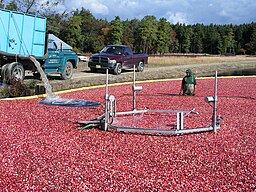
Cranberries are a Fall staple, particularly around Thanksgiving. This Thursday, dishes of cranberry sauce will sit beside the turkey, stuffing, mashed potatoes, and other familiar favorites. Did you know that Rutgers plays a key role in cranberry cultivation in the United States?
The Philip E. Marucci Center for Blueberry and Cranberry Research, located in Chatsworth, NJ, promotes the development and production of high-quality cranberries. Their main activities include studying the effects of various chemicals on cranberries, as well as research into diseases that impact the crop. The Center owes much of its success to the work of Philip E. Marucci, a renowned authority on blueberry and cranberry cultivation. Marucci served as the Center’s chief scientist for over 30 years, and worked as a consultant to the cranberry industry until his death in 1994. Today, the Center continues its research into cranberry cultivation. Its new director, SEBS assistant professor of plant biology Gina Sideli, plans to focus on the problem of fruit rot, a disease that occurs in especially hot and humid conditions and can decimate 10-20% of a cranberry harvest. Professor Sideli also plans to utilize drones in the monitoring of cranberry crops, increasing the efficiency of data collection and allowing the Center to make breeding selections faster.
The cranberry is native to North America and has been cultivated for thousands of years. According to the American Indian Health and Diet Project, hosted by the University of Kansas, cranberries were an important food source for many tribes. Some ate the berries raw, while others dried them and incorporated them into various dishes. One popular recipe that includes cranberries is pemmican, a combination of ground dried meat, animal fat, and dried fruit. Similar to an energy bar, pemmican was easy to pack and carry, and provided a good source of protein. Some groups still make similar recipes today.
Today, cranberries are cultivated in bogs–environments made of layers of sand, gravel, and clay. Most of the cranberries that will be on Thanksgiving tables this week were “wet harvested.” This means that the bogs were flooded with water after the cranberries fell off of their vines. Since each cranberry has four air pockets, they will float to the top, making them easier to collect. Those air pockets also allow cranberries to bounce and, more importantly, to float downriver and disperse seeds.
Cranberry research is ongoing, at Rutgers and elsewhere. Scientists are working on developing molecular markers, which will help identify the locations of specific genes within a cranberry’s genome. With this knowledge, researchers will be able to breed cranberries for different traits, including size, firmness, and color. Commercial varieties of cranberries originally cultivated at Rutgers, are still cultivated and sold. These include the Crimson Queen and Scarlet Knight varieties, along with several others. Through the efforts of the Center for Blueberry and Cranberry Research and of growers around the country, the Rutgers cranberry remains a seasonal staple.